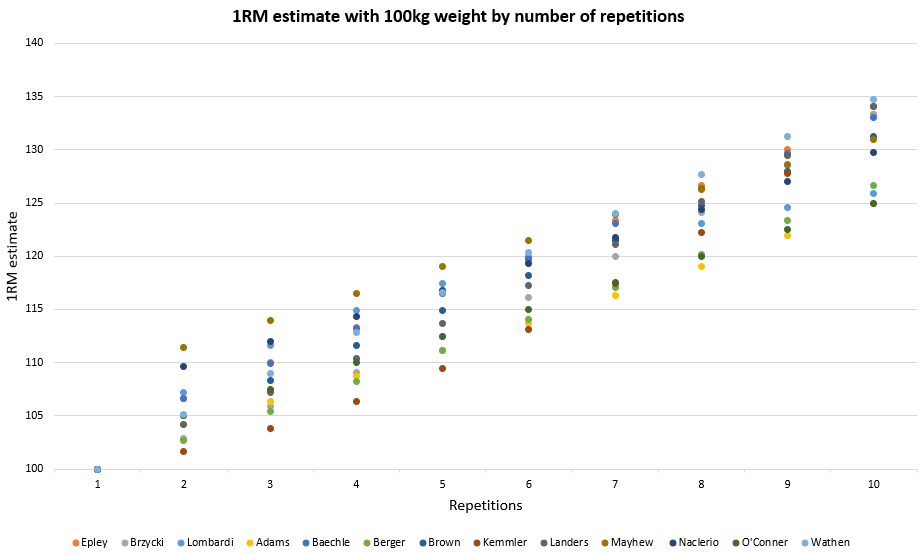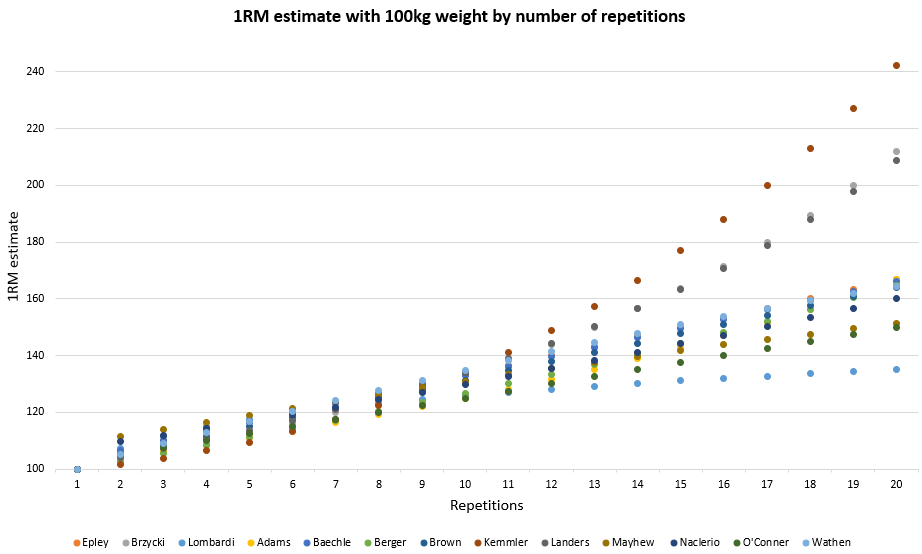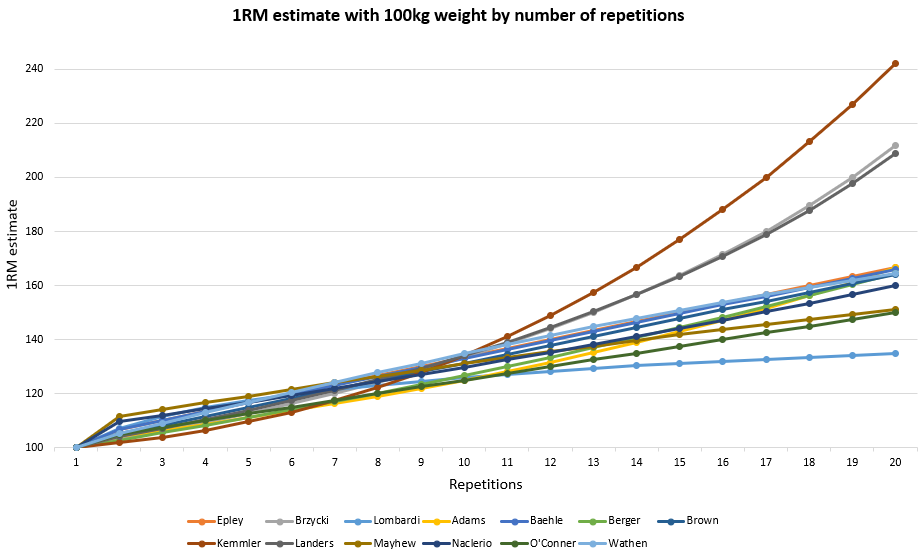1-Rep Max Calculator 💪
Use this calculator to estimate your one-repetition maximum a.k.a. one rep max or 1RM, based on how many reps you can do with a given weight, while maintaining proper form. 1RM calculator to determine your bench press, deadlift, squat, bicep curl and other exercises' 1-rep maximum.
- What is 1RM
- How to calculate your one rep max
- One rep. max. formulas
- How to measure your one rep max
- Workout programming using 1RM
What is 1RM
In weight training, one-repetition maximum weight (a.k.a. one-rep max a.k.a. 1RM) is the maximum weight one can possibly lift for just one repetition. By definition, one should be unable to lift the same weight again, while maintaining the required form, without getting some rest first. One rep. max. is by definition linked to a specific lifting, pushing or pulling exercise, typically with guidelines as to what makes "good form" when performing these exercises. For physiological reasons, a person's one rep max will typically be different on a bench press versus a deadlift versus a squat. What constitutes "good form" may differ between disciplines and may depend on the type of strength one desires to measure, so comparisons between different one rep max measurements should be done with care.
In weight training protocols 1RM can be used as an upper limit which guides what the desired "load" for an exercise should be, typically as a percentage of the one rep max weight. It is used to ensure an exerciser reaches resistance overload by increasing the number of repetitions for an exercise without necessarily adjusting the weight.
How to calculate your one rep max
Using this one rep max calculator, it is easy to estimate your 1RM for any purpose. Simply measure the number of repetitions to failure you can achieve with a given weight and enter both the weight and the number of repetitions. Ideally, you should choose a weight with which you can do between two and ten repetitions. The reason is that the different 1RM calculation methods diverge significantly if the number of repetitions is greater than ten and their accuracy is decreased [2][6][7][8].
Then, choose one of the dozen methods to determine your one rep max through submaximal estimation. All of these methods are based on scientific research, typically on experienced weightlifters, and verified by direct 1RM testing. Despite their empirical basis, the methods disagree to some extent so it is best to choose one and use it consistently. Some of the popular methods include the Epley[1], Brzycki[2], and Lombardi's[3] formulas, with Mayhew et al.'s[4] and Wathen's[5] scoring high in studies of the prediction accuracy of different methods [6][7][8]. See our detailed comparison of the different formulas if you are unsure which one to pick.
Our 1RM calculator will then determine your one-repetition maximum, and also show you how many repetitions you should be able to do with 50%, 60%, 70%, 80%, and 90% of your 1 rep max. All of the predictions are based on the chosen method.
One rep. max. formulas
Our 1-rep max calculator supports more than a dozen equations for estimating 1RM, all based on different scientific studies. Here are some of the more popular formulas:
- Epley's formula: 1RM = weight * (1 + reps / 30)
- Brzycki's formula: 1RM = weight * ( 36 / (37 - reps) )
- Lombardi's formula: 1RM = weight * reps^0.10
- Mayhew et al.'s formula: 1RM = weight * 1 / (0.522 + 0.419 * e^-0.055 * reps)
- Wathen's formula: 1RM = weight * 1 / (0.4880 + 0.538 * e^-0.075 * reps)
The other formulas supported in the calculator are: Adams, Baechle, Berger, Brown, Kemmler, Landers, Naclerio et al., and O'Conner et al..
These equations all try to express the relationship between the number of repetitions one can do with a given weight, and the one-repetition maximum, covering a range of values. Most formulas "agree" what the one-rep max is when estimating based on under ten repetitions, there is significant divergence of the outcomes past this number.
The estimates are suitable for intermediate and experienced lifters with some evidence suggesting they are also useful in untrained populations [9]. The formulae are agnostic to the lifter's age, gender, height, FFM, body fat percentage, arm, chest, and thigh girth. All of these variables have been shown to contribute nothing to 1-RM prediction in a 2006 study by Jeff, Toryanno, and Robert [8].
Comparison of one rep max estimates
Under ten repetitions the formulas are quite consistent with each other. Mayhew's equation produces the highest 1RM estimates when using between two and seven reps, whereas Wathen gives the highest estimates from seven to ten repetitions. The lowest estimates are produced by Kemmler until seven reps, and Adams from seven to ten.

The widely used Epley and Brzycki formulas give the same prediction with ten reps, but Brzycki's estimates are much more conservative compared to Epley's which are among the highest, especially when produced from five to ten repetitions. While some recommend sticking to 5RM for determining one rep max, from the graphs below it is obvious that the divergence between the 1-rep max estimates of different methods is the smallest when determined based on 6 to 10 repetitions. This is an argument to prefer this range when using any 1RM calculator.
While nine of the thirteen methods studied stay close to each other's estimates even after ten repetitions, a notable divergence is exhibited by the methods of Lombardi, Landers, Brzycki and Kemmler for higher number of reps.

Visualizing the estimates as trajectories may help understand how some methods may underestimate (compared to the rest) with low numbers of repetitions while overestimating with a high number of repetitions. Kemmler is the most notable example of such behavior.

If the accuracy of your 1-rep maximum is important, it is best to stick to under ten repetitions, regardless of the method used in our 1RM predictor.
How to measure your one rep max
Directly measuring your one rep max on a bench, deadlift or squat is generally not recommended for beginners to attempt. The risk versus reward trade-off is too poor, especially given that beginners to weightlifting are still learning proper form and the proper technique to minimize injury, the risk of which increases the closer one pushes the limits of his or her strength. Using submaximal estimation is sufficient for most workout programs and weight training protocols. More experienced lifters that want to directly measure their one rep max may want to follow these steps to minimize the risk of injury:
- Use proper safety equipment like lifting belts for deadlifts, safety rails to catch the bar if it falls on you during bench press attempts, and so on.
- Find a spotter who is competent enough to bail you out in case of muscle failure or grip failure. Practice the process with a weight that is well below your max one rep, first.
- Warm up by doing the target exercise with a very light weight for one or two sets of 10-14 repetitions.
- Progressively increase the weight and begin to push closer to your expected one rep max, with enough time to rest in between, but not so much that your muscles get cold again
- Find your one rep max at the weight at which you can do one proper form repetition, but fail to do a second one despite your best efforts (lift to failure).
While the formal 1RM test to failure as the one described above is more accurate, submaximal estimation is both safer and quicker. Even an inaccurate 1RM estimate can be useful as a starting point to calculate the weight needed for a given repetition maximum as a percent of the estimated one rep max.
Workout programming using 1RM
Training sets can be planned around a given percentage of estimated 1-repetition maximum, depending on the lifting goals. For example, explosive power training may involve 50-60% of the 1RM weight with sets of 3-8 reps and very short breaks. 10-15 repetition sets with 65-75% of 1RM can be beneficial for muscle endurance, while hypertrophy (muscle growth) is stimulated across the whole range between 5 and 30 repetitions. For the best trade-off between fatigue and hypertrophy consider sets of 5 to 10 reps with 70-85% of the 1RM weight.
Here is an example break-down for bench-press for someone with 100kg (220 lbs) one-repetition maximum estimated using the Epley method.
| Repetitions | Max. weight | Percentage of 1RM |
|---|---|---|
| 1 | 100 kg / 220 lbs | 100% |
| 2 | 94 kg / 207 lbs | 94% |
| 3 | 91 kg / 200 lbs | 91% |
| 4 | 89 kg / 195 lbs | 88% |
| 5 | 86 kg / 189 lbs | 86% |
| 6 | 84 kg / 184 lbs | 84% |
| 7 | 81 kg / 179 lbs | 81% |
| 8 | 79 kg / 174 lbs | 79% |
| 9 | 77 kg / 170 lbs | 77% |
| 10 | 75 kg / 165 lbs | 75% |
| 11 | 73 kg / 161 lbs | 73% |
| 12 | 72 kg / 158 lbs | 72% |
| 13 | 70 kg / 154 lbs | 70% |
| 14 | 68 kg / 150 lbs | 68% |
| 15 | 67 kg / 147 lbs | 67% |
| 20 | 60 kg / 132 lbs | 60% |
| 25 | 55 kg / 120 lbs | 55% |
| 30 | 50 kg / 110 lbs | 50% |
Note that these figures will vary somewhat depending on the method that produced the 1RM estimate. Brzycki, for example, would predict 100 lbs (45 kg) for the 20-rep max, while Lombardi would determine the 20-rep max weight to be way higher at 165 lbs (74 kg).
Regardless of the chosen 1RM prediction method, plan your workout based on the type of training you want. For example, start with 3-4 sets of 7-8 reps at 80% of the one-rep maximum. Then slowly increase the number of reps for several weeks after which you can compute your new 1RM, and then switch back to 7-8 reps at 80% of the new estimate. That's one way of achieving progressive overload.
References
1 Epley B. (1985) "Poundage chart", Lincoln, NE: Boyd Epley Workout
2 Brzycki M. (1993) "Strength testing: Predicting a one-rep max from reps-to-fatigue", Journal of Physical Education, Recreation & Dance 64(1):88–90
3 Lombardi V. P. (1989) "Beginning weight training", Dubuque, IA: W.C. Brown
4 Mayhew J.L., Ball T.E., & Bowen J.C. (1992) "Prediction of bench press lifting ability from submaximal repetitions before and after training", Sports Medicine, Training, and Rehabilitation 3:195–201
5 Wathen D. (1994) "Load assignment", In T.R. Baechle (Ed.), Essentials of strength training and conditioning (pp. 435–446). Champaign, IL: Human Kinetics
6 LeSuer D.A. et al. (1997) "The Accuracy of Prediction Equations for Estimating 1-RM Performance in the Bench Press, Squat, and Deadlift", Journal of Strength and Conditioning Research 11(4):211-213
7 Terry M.W., Gianni F.M., Rod A.H. (2002) "Accuracy of Seven Equations for Predicting 1-RM Performance of Apparently Healthy, Sedentary Older Adults", Measurement in Physical Education and Exercise Science 6(2):67-94
8 Jeff M.R., Toryanno J.G., Robert A.R. (2006) "Prediction of One Repetition Maximum Strength From Multiple Repetition Maximum Testing and Anthropometry", Journal of Strength and Conditioning Research 20(3):584-592
9 Cummings B., Finn, K.J. (1998) "Estimation of a One Repetition Maximum Bench Press for Untrained Women", Journal of Strength and Conditioning Research 12(4):262-265
Cite this calculator & page
If you'd like to cite this online calculator resource and information as provided on the page, you can use the following citation:
Georgiev G.Z., "1-Rep Max Calculator", [online] Available at: https://www.gigacalculator.com/calculators/one-rep-max-calculator.php URL [Accessed Date: 08 Jan, 2026].